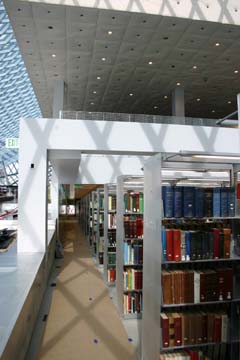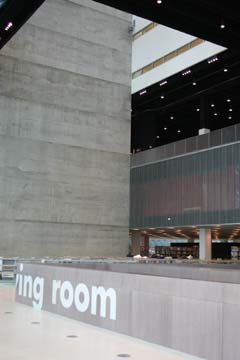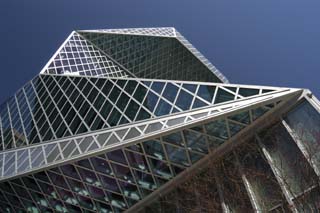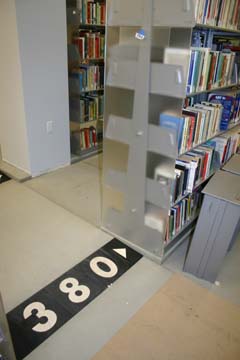
DJC.COM
May 20, 2004
Nuts and bolts shape the library's unique design
Special to the Journal

Photo by Jon Silver
The books spiral winds its way through 3.5 floors like a series of parking ramps. The design allows the library to expand its nonfiction collection without disrupting its Dewey decimal-based order.
|
The design goal for the Seattle Central Library has been to redefine the library as an institution no longer exclusively dedicated to the book, but as an information store where all forms of media — new and old — are presented equally and legibly.
In an age where information can be accessed anywhere, it is the simultaneity of all media and the curatorship of their contents that will make the library vital.
The key components of the design are responsiveness to the program, flexibility and a clear and intuitive building organization. Two of the most original elements of the new design are the books spiral and the mixing chamber.
Innovative program
The building program for the central library was developed prior to the selection of the design team. It delineated precise square footage requirements for each portion of the library along with suggested spatial adjacencies. Typically, the program is the outline by which the design develops.

Photo by Jon Silver
The fifth-floor mixing chamber (reference area) overlooks the living room, which houses the fiction shelves, gift shop and a coffee cart. Directly below the mixing chamber is the meeting-room level.
|
The design of the 363,000-square-foot central library is very much a product of its program. But instead of a literal interpretation of the program, the program was applied to a completely new consideration of library functions and organization. So while the library's programmatic needs are met, they are fulfilled in a radically innovative manner.
Tailored flexibility
Flexibility in contemporary libraries is conceived as the creation of generic floors on which almost any activity can happen. Programs are not separated, rooms or individual spaces not given unique characters.
In practice, this means that bookcases define generous reading areas on opening day but inevitably come to encroach on the public space through the collection's expansion. Ultimately, in the traditional form of flexibility, the library loses the very attractions that differentiate it from other information resources.
The Seattle Central Library cultivates a more refined approach by organizing itself into spatial compartments, each dedicated to, and equipped for, specific duties. Tailored flexibility remains possible within each compartment, but without the threat of one section encroaching on the others.
Five platforms

Photo courtesy of Seattle Public Library
The design of the 11-story library is a departure from the typical symmetrically stacked high-rise. Steel grids support the glass between five main platforms that contain the library’s primary functions.
|
The first step in the design was to “comb” and consolidate the library's apparently ungovernable proliferation of programs and media. By combining like with like, programmatic clusters were identified — five of stability and four of instability. The stable clusters became five “platforms” or boxes that contained and constrained the program elements within them. The unstable program elements became four “in-between” spaces linked by an atrium.
Each platform is a programmatic cluster that is architecturally defined and equipped for maximum, dedicated performance. Because each platform is designed for a unique purpose, their size, flexibility, circulation, materials, structure, and mechanical and electrical systems vary.
The spaces in between the platforms function as public floors where librarians inform and stimulate, where the interface between the different platforms is organized — spaces for work, interaction and play.
By modifying the superposition of floors in the typical American high-rise, a building emerges that is at the same time sensitive (the geometry provides shade or daylight where desirable), contextual (each side reacts differently to specific urban conditions or desired views) and iconic.
Books spiral

Photo by Jon Silver
The library’s wayfinding devices, such as the Dewey decimal mats in the books spiral, were designed to be simple and intuitive.
|
The problem of traditional organization of library books is flatness. Departments are organized according to floor plans. Each floor is discreet; the unpredictable fits of growth and contraction in certain sections are, theoretically, contained within a single floor.
In 1920, the Seattle Public Library had no classification for computer science — by 1990 the section had exploded. As collections unpredictably swell, materials are dissociated from their categories. Excess materials are put in the basement, moved to off-site storage or encroach upon unrelated departments. Discontinuous collections become counterintuitive to patrons who need more and more wayfinding assistance from librarians.
The books spiral represents a reaffirmation of the much-compromised Dewey decimal system. By arranging the collection in a continuous ribbon — running from “000” to “999” — the subjects form a coexistence that approaches the organic; each evolves relative to the others, occupying more or less space on the ribbon, but never forcing a rupture.
For the Seattle Central Library, the spiral's 6,233 bookshelves will have a capacity to hold up to 1.45 million books. Patron wayfinding is intuitive and simple — augmented with graphics in the elevators and on the floor of the spiral itself, which changes as the collection shifts.
Mixing chamber
The simplicity of the books spiral frees the reference librarians to gather in one central location, the mixing chamber. The mixing chamber is an area of maximum librarian-patron interaction, a trading floor for information orchestrated to fulfill an essential and often neglected need for expert interdisciplinary help.
The mixing chamber consolidates the library's cumulative human and technological intelligence: the visitor is surrounded by information sources. Reference services will be proactive, flexible, collaborative and seamless in the delivery of information and resources to the customer. Questions are answered in the mixing chamber.
The library's 11 levels include the reading room, books spiral, mixing chamber, meeting platform, living room, staff floor, children's collection and auditorium, and parking — all of which are articulated for the building's primary function and overall users' experience. The design strives to meet the needs of the library and the city far into the future.
OMA/LMN — A Joint Venture is the architect for the Seattle Central Library. Joshua Ramus of the Office for Metropolitan Architecture is the partner in charge, and Sam Miller of LMN Architects is the project director. Both helped lead the design and delivery of the project.
Other Stories:
- Do we really need libraries anymore?
- College libraries cater to widening needs
- Living rooms for urban neighborhoods
- Dozens of library projects on tap for Seattle, King County
- Libraries: the next must-have amenity
- Library's tech system is also daring and elegant
- Intuitive design yields unlikely results
- Divining the cost of an oddball building
- Neighborhood libraries get big-city treatment
- Library lights lift a heavy load
Copyright ©2009 Seattle Daily Journal and DJC.COM.
Comments? Questions? Contact us.